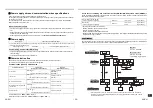
– 11 –
21-EN
22-EN
Installation of remote
controller (sold separately)
For installation of the wired remote controller, follow the
Installation Manual attached with the remote controller.
• Pull out the remote controller wire together with the
refrigerant pipe or drain pipe.
Pass the remote controller wire through upper side of
the refrigerant pipe and drain pipe.
• Do not leave the remote controller at a place exposed
to the direct sunlight and near a stove.
Wireless remote controller
(sold separately)
The signal receiving unit of indoor unit can receive a
signal by distance within approx. 7 m.
Based upon it, determine a place where the remote
controller is operated and the installation place.
• Operate the remote controller, confirm that the indoor
unit receives a signal surely, and then install it.
• Keep 1 m or more from the devices such as
television.
(Disturbance of image or noise may generate.)
• To prevent a malfunction and reception failure of the
remote controller, select a place where it is not
influenced by a fluorescent light, equipment
(Electronic whiteboard etc.) emitting infrared rays, or
direct sunlight.
• Switching the setting (A-B selection) of the wireless
remote controllers and the signal receiving unit
enables two indoor units installed in a room to be
respectively operated using two wireless remote
controllers
7 m
or
le
ss
5
Drain piping
CAUTION
CAUTION
Following the Installation Manual, perform the drain piping work so that water is properly drained. Apply a heat insulation so
as not to cause a dew condensation.
Inappropriate piping work may result in water leakage in the room and wet furniture.
• Provide the indoor drain piping with proper heat insulation.
• Provide the area where the pipe connects to the indoor unit with proper heat insulation. Improper heat insulation will cause
condensation to form.
• The drain pipe must be sloping downward (at an angle of 1/100 or more), and do not run the pipe up and down (arched
shape) or allow it to form traps. Doing so may cause abnormal sounds.
• Restrict the length of the traversing drain pipe to 20 meters or less. For a long pipe, provide support brackets at intervals of
1.5 to 2 meters to prevent flapping.
• Install the collective piping as shown in the following figure.
• Do not provide any air vents. Otherwise, the drain water will spout, causing water to leak.
• Do not allow any force to be applied to the connection area with the drain pipe.
• A hard PVC pipe cannot be connected to the drain pipe connecting port of the indoor unit. Be absolutely sure to use the
flexible hose provided for the connections with the drain pipe connecting port.
• Adhesive agents cannot be used for the drain pipe connecting port (hard socket) of the indoor unit. Be absolutely sure to
secure the pipe using the hose bands provided. Use of an adhesive agent may damage the drain pipe connecting port or
cause water to leak.
Arched shape
1.5 m to 2 m
Support
bracket
Heat insulator
Downward slope
1/100 or more
(Collective
piping)
As long as possible
(Approx. 10 cm)
Downward slope
1/100 or more
VP30
Trap
Incorrect
Drain pipe
connecting port
(Hard socket)
Attached hose band
Adhesive inhibited :
Use the attached flexible hose and hose band for connecting
the drain hose to the clear drain socket. If applying the
adhesive, socket will be damaged and cause water leakage.
Indo
or uni
t
Soft socket
Hard socket
Socket for VP25
(Locally procured)
Attached flexible hose
VP25 vinyl chloride pipe
(Locally procured)
15 mm or less*
10 to 12 mm
Hose band tightening
margin
Indoo
r uni
t
VP25 vinyl chloride pipe
(Locally procured)
Drain pipe
connecting port
(Transparent)
10 mm
Flexible hose
(Accessory)
Heat
insulator
Socket for VP25 vinyl
chloride pipe
(Locally procured)
* Natural water draining (Lower pipe): 5 mm or less













































